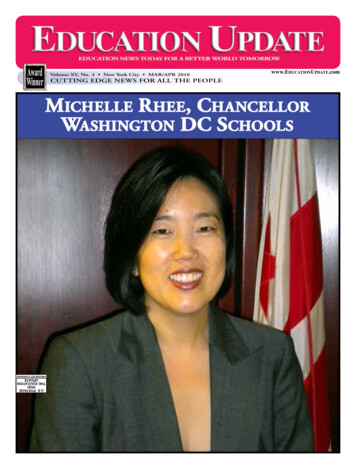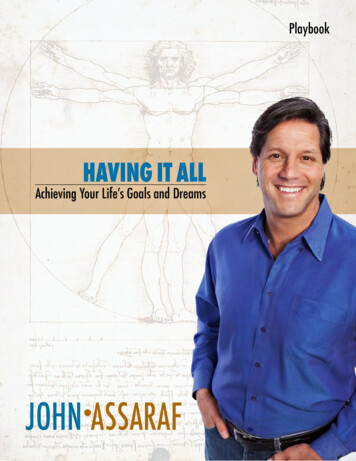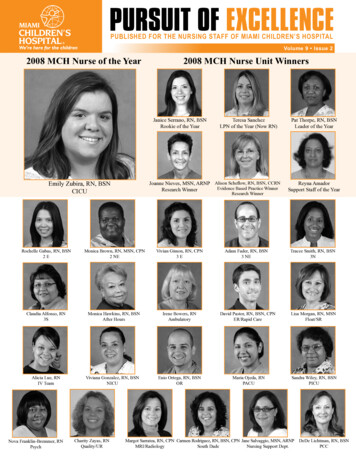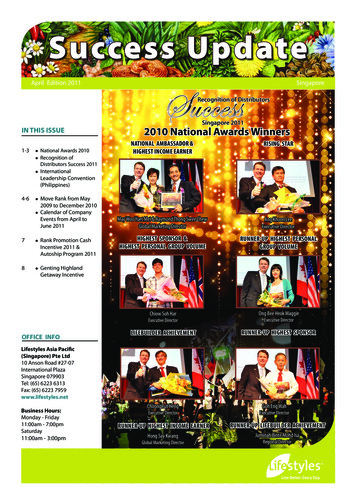
Transcription
AwardAwardWinnerWinnerVolume XV, No. 4 New York City MAR/APR 2010www.EducationUpdate.comCUTTING EDGE NEWS FOR ALL THE PEOPLEMichelle R hee, ChancellorWashington DC SchoolsPRESORTED STANDARDU.S. POSTAGEPAIDTHE EDUCATIONUPDATE
update ForParents,Studies Ad forEducationEducation Update:Layout1 3/5/10 9:23AM Page1Graduate Studies@2GraduateBiology(MS)(MS)MAR/APR 2010Cinema andMedia StudiesEducation(MSEd)EnglishChildhood, Adolescence, andSpecial Education(Post-Master’s Advanced Certificate)Leadership in EducationEnvironmentalScienceHistoryMental HealthCounselingNeuroscience,Mental Retardation, andDevelopmental Disabilities(MA)(MS)(MS) BusinessManagement(MS)Computer Sciencew w w. c s i . c u n y. e d u / g r a d u a t e s t u d i e sEducators & Students(MA)(MA)LiberalStudies(MA)(MS)Nursing(MS and Post-Master’s AdvancedCertificate)Adult Health NursingGerontological(Post-Master’s Advanced Certificate)Nursing EducationCultural CompetenceDoctoral ProgramsComputer Science (PhD)Biochemistry (PhD)Biology (Neuroscience) (PhD)Nursing (DNS)Physical Therapy (DPT)Physics (PhD)Chemistry (PhD)All doctoral programs are offered jointly with The Graduate Center of The City University of New York.College of Staten Island Office of Recruitment and Admissions, 2800 Victory Boulevard, 2A-103, Staten Island, NY 10314, 718.982.2010www.csi.cuny.edu/admissions
10AA Lit EducUp01 ad:Layout 112/8/09MAR/APR 2010 4:00 PMPage 1For Parents, Educators & Students 3Education updateThe Teacher’s Choice forExcellentLiteracy/ Reading / Language ArtsPrograms#1VocabularyProgramin U.S.Grades 2–12PreK–6Grades 3–5Grades 6–12Grades 2–3Grades 6–12Call today for your free evaluation copies, 877-930-3336.Mention Promo Code K5.
4Education update For Parents, Educators & StudentsGUEST EDITORIALHow Far Have We Come?By Dean Mary BrabeckMarch is Women’s History Month, so this isan apt time to think about the question, “Howfar have we come?” My own discipline, psychology, has been replete with stereotypical views ofwomen that have created — rather than reflected— reality, especially research about women’sleadership ability and interests. In the 1900s, psychology embraced the assertion that women andmen belong in “separate spheres.” His sphere,they argued, is the public world of achievement, power, and influence. Her sphere, theyconcluded, is the private world of home, hearthand caring for others. And psychology advanceda number of theories about “women’s nature” tobolster that view.Psychology taught us that women, unlike men,have less achievement motivation and less needfor power; that claim was refuted by evidence.Then psychologists told us women feared successmore than men; but research showed that was notthe case, either. And more recently it has beenasserted that women choose a “mommy track,”which is used to explain why women still make79 cents to every dollar that men make, why theSenate is overwhelmingly male (83 men vs. 17women), and why only 2 percent of CEOs inFortune 500 companies are women.While it is true that men are more likely toemerge as leaders in laboratory experiments onleadership, dominance and power, the real worldis more complex than the research lab, and studieshave also shown there are structural barriers (the“glass ceiling,” parental practices, etc.) to womenachieving the top leadership positions. But timesare changing. Historically, men have been morelikely to graduate from college, earn professionaldegrees, and complete their doctorates. Today, atall levels of education, both globally and locally,where women have access to education, theyare catching up — and in some cases surpassing — the achievements of men. The results areclear. Hillary Clinton became the first womanto launch a successful campaign for presidentof the United States (albeit most exclusively inpantsuits). The Ivy League boasts more femalepresidents than ever before: President Drew Faustat Harvard, President Ruth Simmons at Brown,President Amy Guttman at the University ofPennsylvania, and President Shirley Tillman atLETTERS TOTHE EDITOR MAR/APR 2010Education UpdateFayetteville, North CarolinaThe Incredible Maxine GreeneTo the Editor:I am a Ph.D. student at Walden University.While researching many topics for an assignment comparing educational philosophies, I cameacross your article on Dr. Greene. I adore herwork, effort and courage in standing up for ourcountry.Theodore RegisBandung, IDahoFreedom Writers: Erin GruwellTo the Editor:I love it! I just watched the movie, The FreedomWriters. I admired her. Her willingness to keepthe students was a good example for all of theteachers around the world.RaniPrinceton; MIT’s President Susan Hockfield addsto the list and, recently, the venerable Universityof Virginia announced that Teresa A. Sullivanwill become its first female president.Even at home in New York, where the facesare intractably male on Wall Street and in NewYork magazine’s lists of the “best lawyers” and“best physicians.” Education Update has keptus aware of women’s leadership in our state:Chancellor Merryl Tisch leads New York’sBoard of Regents; Chancellor Nancy Zimpherheads the State University of New York system;President Susan Fuhrman leads Teachers College,Columbia University; President Elizabeth Dickeyleads Bank Street College; President JenniferRaab leads Hunter College; Christine Quinn isCity Council speaker; and Randi Weingarten ispresident of the AFT.Of course women are not the majority of university presidents, and I am not arguing thereshould be a quota. I am only saying that whenour theories catch up with reality, new possibilities arise — which reminds me of SamuelJohnson, who once was asked, “Who is smarter,men or women?” Johnson quipped, “Which man?Which woman?”This March we also celebrated InternationalWomen’s Day (March 8). IWD is a yearlyreminder of the global economic, political, andsocial achievements of women. In some partsof the world, like China, Russia, Vietnam andBulgaria, IWD is a national holiday. The firstIWD was run in 1911, so we are a year awayfrom the centenary. We have a year to work onadjusting our stereotypes to the new reality ofwomen and leadership. Real progress will havebeen made when we take for granted women’sability to lead, and when women no longer makeheadlines for being the “first woman” to lead anorganization (or country!). We are a society anda world that needs all the leadership talent wecan muster. #Mary Brabeck is dean of the Steinhardt Schoolof Culture, Education and Human Developmentat NYU.Glencoe, IllinoisHigh School Reunions: Music and Art, NewYork CityTo the Editor:M&A (as we called the school affectionately)stands for art as well as music, and its halls andstudios were filled with the smell of oil paint,linseed oil, works on canvas, paper, ceramics,graphic arts, sculpture, as well as the sounds ofchorus, instruments, and orchestra. Our almamater was written to the melody of the fourthmovement of Brahms’ First Symphony and starts,“Now upward in wonder ” Fifty-eight yearslater, I still gaze upward to that Castle on the Hill,my memory as bright as the first day I climbedthat hill from the 135th Street station below.Nina RaskinLima, PeruBilingual Education for the 21st CenturyTo the Editor:This one of the greatest articles I’ve ever readabout this topic. I’m glad to have had the chanceto come across this interesting piece of writing asI’m doing research on bilingual education.Ana Maria BallesterosIn This IssueSpotlight on Schools. . . . . . . . . . . . . 2-6Guest Editorial . . . . . . . . . . . . . . . . . . 4Letters to the Editor . . . . . . . . . . . . . . 4Medical Update. . . . . . . . . . . . . . . . . . 7Special Education. . . . . . . . . . . . . . 8-11Journalism Initiative. . . . . 12Camps. . . . . . . . . . . . . . . . . . . . . . . . 13Cover Story. . . . . . . . . . . . . . . . . . 14-17Colleges & Grad Schools . . . . . . . . 19-31Music, Art & Dance. . . . . . . . . . . . . . 20Sports. . . . . . . . . . . . . . . . . . . . . . . . . 21Books . . . . . . . . . . . . . . . . . . . . . . . . 22Crossword. . . . . . . . . . . . . . . . . . . . . 23Museums. . . . . . . . . . . . . . . . . . . . . . 24Poetry . . . . . . . . . . . . . . . . . . . . . . . . 25Law. . . . . . . . . . . . . . . . . . . . . . . . . . 27Movies. . . . . . . . . . . . . . . . . . . . . . . . 30Education Updateis an independentnewspaper.
Scientific Women:NYTEdLife copyMAR/APR 2010 3/5/104:34 PMPage 1For Parents, Educators & Students 5Education updateBREAKINGBOUNDARIESI N S CIENCE RESEARCHPolymer andmaterialscienceVenomous toxinsfor l physicsBraincancerinfiltrationFluorescence spectroscopy of complex biomoleculesSpiraling clockwise fromupper right: Dr. Myriam Sarachik, Distinguished Professor ofPhysics, City College; Dr. NeepaMaitra, Associate Professor ofPhysics, Hunter College; Dr. MarieFilbin, Distinguished Professor ofBiology, Director of the SpecializedNeuroscience Research Program,Hunter College; Dr. Lesley Davenport, Professor of Chemistry, Brooklyn College and CUNY GraduateCenter; Dr. Vicki Flaris, Assistant Professor of Chemistry, BronxCommunity College; Dr. MandëHolford, Assistant Professor ofChemistry, York College and CUNYGraduate Center; Dr. MaribelVazquez, Associate Professor ofBiomedical Engineering, City CollegeSpinal cord injury repairBreaking boundaries in science at The City University of New York —Distinguished women scientists at all CUNY colleges are making history all year roundby conducting pioneering research in fields that are critical to our nation’s future. ThroughCUNY’s “Decade of Science,” they are teaching and working with outstanding studentsin laboratories and classrooms in cutting-edge areas of applied and basic science. ViceChancellor for Research Gillian Small and Vice Chancellor for Facilities Planning,Management and Construction Iris Weinshall are working together on the programmingand construction of the new CUNY Advanced Science Research Center at City College.World-class faculty. Breaking Boundaries. Making History. All year round at CUNY.For more information aboutCUNY women in science visit www.cuny.edu/decadeofscienceMatthew GoldsteinChancellor
6spotlight on schools EDUCATION UPDATE Tuesday, January 26 5:30 PM - 7:0 PMMAR/APR 2010Teachers College Conference on Educational EquityRebell Hosts 5th Annual SymposiumBy Adam BlochProfessor Michael A. RebellTC President Susan Fuhrmanby Sybil MaiminHow much has the stimulus done for education?That question drew some sharply different answersfrom education experts and researchers at therecent fifth annual Equity Symposium at TeachersCollege. The two-day conference was titled,“Stimulating Equity? The Impact of the FederalStimulus Act on Educational Opportunity.”The one point of unanimity among participantswas that the extra funds included in the AmericanRecovery and Reinvestment Act, which doubledfederal education spending to roughly 100 billion, have helped save thousands of jobs by closing enormous budget gaps for schools across thenation. But whether the funds have also spurredreform remained up for debate.Jack Jennings, President and CEO of the Centeron Educational Policy, presented a study thatsurveyed governors and state school superintendents in 44 states and the District of Columbia.Based on his findings, he concluded that the dualpurposes of saving jobs and creating change arebeing met. “The federal government has gotten theattention of the states when it comes to reform,”Jennings said.Jennings said that 41 states are applying tothe Race to the Top Fund, and 33 are considering adopting common standards. Of the four“assurances” sought by Race to the Top, schoolshave had the easiest time implementing new datasystems and rigorous standards and assessments.Ensuring reform of low-performing schools andthe effectiveness and equitable distribution ofteachers has been harder. “It’s common sense,”Jennings explained, “because to address teachereffectiveness and low-performing schools, youhave to deal with local districts, colleges of education, just a plethora of different forces.” Mostimportantly, in an economic sense, Jennings estimated that stimulus funds have created or savedbetween 250,000 and 300,000 jobs.Jessica Wolf and Daniel Yaverbaum, a policy director and researcher at the Campaign forEducation Equity, respectively, presented a surveyof their own that was far less optimistic. “Wedon’t believe these four assurances are beingmet,” Yaverbaum said. “They’re simply not at theforefront of district policies. When we asked howdistricts were doing with reform, we got reactionsranging from laughter to disappointment.”The survey looked at 20 states and, accordingto Wolf, revealed that stimulus money was largelysuccessful in maintaining educational funding. Themoney was often applied to Title I and Individualswith Disabilities Education Act requirements.Other uses included new hardware, new softwareand expanded professional development. Most ofthe funds, however, were used to avoid layoffs.“It is not clear if this will have long-term effects,”Wolf said.The final study was presented by Bruce Baker,a professor at Rutgers University, and DavidSciarra, the executive director of the EducationLaw Center. They focused primarily on fundingformulas and also reached worrisome conclusions.According to their findings, stimulus funds hadno impact on the fairness of state formulas andmay have enabled disproportionate cuts in povertyareas. Moreover, fiscal years 2011 and 2012 willprobably require large budget cuts in most states.“Many states used this to make the distribution oftheir funds to high-poverty areas worse,” Sciarrasaid. “Congress had no idea what they were gettinginto and no idea how bad, how regressive some ofthese funding formulas were.” #RSVPAdmis onsOfice:21 -362-04 0 ext.127or email:admis ons@yorkprep.orgwhat investment in education should look like,”Everyone is voicing opinions about the fed- and difficulties in talking about “shifts, likeeral government’s response to the economic reallocating from the haves to have-nots.” Sherecession. The Campaign for Educational Equity would like to see the media generate sustainedat Teachers College, Columbia University got public conversation about educational equityinto the act at their fifth annual symposium, and the political will to effect it. “This is about“Stimulating Equity? The Impact of the Federal power,” she declared, “and who gets opportunity.Stimulus Act on Educational Opportunity.”Parents who don’t want other people’s childrenThe American Recovery and Reinvestment Act to get power stand in the way. They don’t want toof 2009 (ARRA) is giving states the enormous change the way the world looks.”sum of 100 billion to be spent on education overAs director-counsel and president of thea two-year period. After one year, the goal of NAACP Legal Defense and Educational Fundstabilization, or helping states maintain their pre- from 2004-08, Columbia law professor Theodorerecession levels of funding and service, has most- M. Shaw litigated many education matters and Governor Patterson did not come to office wantly been met. According to Michael A. Rebell, an learned, “Sometimes when you lose, you win, ing to cut education, Shaw explained, but “heattorney and executive director of the Campaign and when you win, you lose. When politically faced a different reality.” Politics and legalitiesfor Educational Equity, who spoke at the sym- you can’t raise taxes, you can’t get a state to are in conflict. How do we reconcile them? Toposium, the problem is how the funds are being fund a remedy. It is always a problem, and Rebell, even in difficult times, we “must estabspent. His research shows “negative effects”on worse in hard times.” The question is, “How lish the principle that core constitutional rights2009 York Prep Open House F 7/21/09 4:53 PM Page 2continued on page 28disadvantaged children as promised programs do you make constitutional principles reality?” are sacrosanct.” #to encourage reform and equity arebeing neglected in favor of closingbudget gaps. This not only defiesthe “adequacy and equity” provisionsYork Preparatory Schoolof ARRA, charges Rebell, it is alsounconstitutional. He explains that,40 West 68th Streetrepeatedly, courts have declared thatNew York, NY 10023children have the constitutional rightwww.yorkprep.orgto a good education, and that theserights must be respected, even in timesof fiscal cutbacks. Acknowledgingthat Governor David Patterson is in“a difficult situation” and is requiredby law to balance the state budget,Rebell insists that the constitutionalmandate to provide a “sound basicDearYork Parents:Prep is a co-educational collegeeducation” to all children is equallyYouarecordiallyinvited offeringto attendaoneof ourpreparatoryday schooltraditionalbinding. To address the problem ofOPENHOUSESat YorkPreparatorySchool.curriculumfor grades6-12.In the beliefshortfalls, Rebell points to “proverbialwaste and inefficiency” and proposesthat every studentcan30succeed,we provideWednesday,September5:30 PM- 7:00 PMcutting costs. He notes AMisWednesday, October 79:30 AM - 11:00compliance need not be at a set priceWednesday,October145:30richnessPM - 7:00 PMenhanced bythe diversityandas long as core services for a sound,Tuesday,205:30 PM - 7:00 PMof New OctoberYork City.basic education are provided. RebellWednesday, October 289:30 AM - 11:00 AMsuggests cost studies to determinehow much is needed for core services.Wednesday,November45:30 PMas- the7:00 PMYork Prep recognizes the studentHe wants rainy-day funds establishedWednesday, November 11 9:30 AM - 11:00 AMfocus of the educational process. Eachin good times, zero-based budgetingTuesday, November 175:30 PM - 7:00 PMstudent is challenged to thinkcriticallythat requires justification for everyWednesday, December 25:30 PM - 7:00 PMprogram, multi-year budgeting toand creativelyTuesday,Januaryin12a structured5:30environmentPM - 7:00 PMavoid financial surprises and instawhereexcellenceisrewardedandTuesday, January 265:30 PM - 7:00 PMbility, and school district consolidaindividuality is encouraged. We strive totion for greater efficiency. Calling itRSVPAdmissionsOffice:212-362-0400ext. 127developresponsiblecitizensby reinforcinghis most contentious proposal, Rebelloremail:admissions@yorkprep.orgadvocates teacher pension reform withrespect for self and others.a scaling back of benefits.Respondents to Rebell’s remarksYork Prep is a coeducational college preparatory school for grades 6-12.suggested difficulties inherent in proposed solutions. Jamienne S. Studley,www.yorkprep.orgpresident of Public Advocates, Inc.and former president of SkidmoreCollege, sees “lots of confusion aboutYorkPrepisacoeducationalcoleg pre ar toryscho lforgades6-12.“An Intimate Place to Learnin the Heart of a Great City”w w.yorkprep.org
7 New York City MAR/APR 2010NewYork-Presbyterian Hospital President andCEO Dr. Herbert Pardes Speaks on Health Care ReformDr. Herbert Pardes has shared his thoughtson national health care reform and PresidentObama’s health care summit. Dr. Pardes leadsNewYork-Presbyterian Hospital, ranked amongthe nation’s top hospitals by U.S. News & WorldReport. He is a nationally recognized expert onhealth care reform who has provided his insightto The Economist, The Wall Street Journal, TheNew York Times, CNBC, MSNBC, NPR and FoxBusiness News.“I think what is going to be involved here is acollective responsibility, and I think we as individual citizens throughout the country have torealize that we play a role in health care reform,”says Dr. Pardes. “We need to improve our ITsystem, strengthen quality and safety, implementmalpractice reform, streamline billing practices,and work with health care consumers to improvethe health of the population.”He addressed several topics related to healthcare reform:What are the top priorities for health carereform? Provide access to health coverage to allpeople in the U.S. Maintain the highest quality of medicine thatis available in the U.S.How can academic medicine improve overall quality? Evaluate best information technology toimprove care and hold down costs. Test quality measures to make sure our standards for care maintain best practices of qualityin health care. Train more physicians and nurses to meethealth care demand.What should be changed in health carereform bills? More resources should be used to train newdoctors and nurses to care for the 30 millionmore people who will have health insurance. Disproportionate Medicare funding should beamended so the nation cuts funds only after thenumber of underinsured drops.Childhood ObesitySHH EdupdateAd 5x6.75 v1:Layout 11/13/1011:32 PMPage 1andHelp for Your Troubled Teen.Peace of Mind for You.If your teenager is struggling with a psychiatric, substance abuseor eating disorder, don’t let it tear your family apart.We offer an advanced specialty in Adolescent Care, at oneof the finest psychiatric hospitals in the country.Learn more at silverhillhospital.org or call us at(800) 899-4455 Regional differences in Medicare costsshould be studied to better reflect true costs forhealth care by region as well as quality differences.How can health care reform hold downcosts? Reduce or eliminate unnecessary costs byreforming medical malpractice and standardizinginsurance forms, which alone can eliminate 500million to 700 million in health care costs. Health care costs vary regionally, so costs inthe Northeast will be different from the Midwest.How can health care policy make the publichealthier? A tremendous amount of the expense ofhealth care in this country is related to behavior;we can save money by helping people to eathealthy, quit smoking and exercise. Schools can improve health care by raisinghealth education to the importance of scienceand math, and coordinating health education,gym and school nutrition programs.Its Effecton Incentives should be implemented by insurance companies and employers to encouragehealthy behavior.#Herbert Pardes, M.D., is president and chiefexecutive officer of NewYork-PresbyterianHospital and NewYork-Presbyterian HealthcareSystem, and is nationally recognized for hisbroad expertise on health care reform, healthpolicy, hospitals, health care technology, mentalhealth, research, education and clinical care.He has been named one of Modern Healthcare’s“100 Most Powerful People in the HealthcareIndustry” and Modern Physician’s “50 MostPowerful Physician Executives.” Prior to joining the hospital in 1999, Dr. Pardes served asdean of the faculty of medicine at ColumbiaUniversity College of Physicians and Surgeons.Prior to that, he served as director of theNational Institute of Mental Health and as U.S.assistant surgeon general during the Carter andReagan administrations, and was also presidentof the American Psychiatric Association.Self-EsteemBy Margaret Lewin, MD, FACPMore than 30 percent of American childrenare overweight (50 percent in African-Americanand Latino communities), and more than twothirds of obese children over the age of 9 willbecome obese adults. The resulting medicalproblems of diabetes, premature heart disease,stroke, gallbladder disease, degenerative arthritis, breathing problems and sleep apnea, as wellas cancer of the uterine lining, breast, prostateand colon are well-known, but the psychological problems surprisingly less so. Societyin general responds negatively to obese individuals. Obese children in particular are oftensocially stigmatized and face discriminationfrom their peers, teachers, and even physiciansand nurses — often leading to poor self-esteem.Self-esteem refers to an individual’s sense ofhis or her value or worth — a favorable orunfavorable attitude toward one’s self. Formalstudies show that parents’ and peers’ acceptanceweigh most heavily on many children’s sense ofself-esteem. In a country with very thin celebrity role models and where it is common to say,“you can never be too thin,” being obese canbe devastating to self-esteem, especially duringchildhood and adolescence.Children can be cruel, especially to overweight peers who are often teased about theirweight. Although any child whose physicalappearance or intellectual capacity differs fromthe norm often is subjected to merciless teasing,it can be worse for obese children — who areblamed for their “different-ness” and closelywatched (and criticized) in their eating andexercise habits. Studies have shown that obesechildren tend to have a smaller circle of closefriends, leading to isolation and loneliness.Parents often join in the torment even if theyare also overweight. It can be difficult to escapefrom the self-image of unattractiveness andbody dissatisfaction.Formal studies suggest a relationship betweenself-esteem and health. Whether obese or not,adolescents with poor self-esteem are morelikely to engage in early sex, less likely to usebirth control, have higher rates of teen pregnancies, are more likely to use tobacco, alcohol andillicit drugs, and to attempt suicide. Obesity canalso lead teenagers into binge-eating, sometimes purging as well. In 2007, a study reporteda 20-year research of obese adolescents inUpstate New York. They found that obese girlswere nearly four times more likely than normalweight girls to suffer major depression andanxiety disorders as adults.Obese children can have a brighter future.This year, Sacher published the results ofa randomized, controlled British trial of theMEND (Mind, Exercise, Nutrition, DO it) program, a family-based community interventionfor childhood obesity. Parents and their obesechildren attended eighteen 2-hour group educational and physical activity sessions held twiceweekly in sports centers and schools, followedup by a 12-week free family swimming pass.Compared to the controls, the study children notonly reduced their weight and waistlines andincreased their cardiovascular fitness and physical activity levels, but they also had significantimprovement in their self‑esteem.Doing something about childhood obesityand related issues of self-esteem is a kindness, but we also need to do so in our ownself-interest. The economic consequences ofchildhood (and subsequent adult) obesity arestaggering and threaten to overtake our healthcare system and national budget. For these reasons, Michelle Obama, Surgeon General ReginaBenjamin, The Centers for Disease Controland Prevention, Federal Trade Commission,Food and Drug Administration, Department ofAgriculture, and the nation’s mayors and otherlocal leaders are placing a high priority oncombating this growing problem. It will requireenormous investing in education, availabilityof food in schools, making healthy affordablefood more accessible in low-income neighborhoods, building schools within walking distanceof residential areas, and building playgroundsand walking and biking paths. It will involvesetting standards for marketing food to children and reconsidering the nutritional value offoods available on supermarket shelves. Theseinvestments are worth it — both to us and ournation’s children. #Dr. Margaret Lewin is chief medical directorof Cinergy Health.
8Special Education EDUCATION UPDATE MAR/APR 2010Connect with the Bloggers onwww.EducationUpdate.comVisit our preeminent scholars to find out thelatest in news and views in education, specialneeds children, psychology, psychiatry,writing, scholarships, music and art,books, colleges, careers and more.Our bloggers now include: Ernest Logan, President, Council of SchoolSupervisors and Administrators Dr. Allen Frances, former Chief of Psychiatry,Duke University School of MedicineOur Center uses an integrated model that Dr. John J. Russell, Head of WindwardOurCenteruses an rcombinesusesanmodelthat Dean Jerrold Ross, St. John’s Universityandlanguageandintegratedoccupational therapytechniquesto formpathwaysforandlanguageand effectiveoccupationaltherapyGo online with our bloggers and interact withines techniquespsychological,behavioral,speechthem. Their responses will amaze you!learning and attention.to formeffective pathwaysOur Center usesan integratedmodel thatforlearningattention. spsychological,speechRebecca School Looksniques to form effective pathways for the Big PictureWe offer the following services:and languageand occupationaltherapy DevelopmentalAssessmentsOur Centerusesanintegratedservices:model s for offerIndividualEducationProgramscombines psychological, behavioral, speechDevelopmental and language and occupational therapy ABATherapy Education ProgramsIndividualtechniques to form effective pathways for followingservices:learningandattention. Occupational Therapy DevelopmentalABA Therapy Assessments Sensory IntegrationWe offerIndividualthe followingservices:Speech/LanguageTherapyPrograms SchoolVisitsEducation DevelopmentalAssessmentsOccupationalTherapy ProgramSupervision Individual Education ProgramsFor moreinformationabout our program, ABASensoryIntegration Therapy Program Supervisionpleasevisitour websiteatSchoolVisits Speech/LanguageTherapy ABATherapywww.mccartoncenter.com. Occupational Therapy tegrationFor moreinformationabout our program,Contact: Carolynn Barnes visitSensory SchoolVisitspleaseourIntegrationwebsite at School Visits350 East 82nd Street, New York, NY 10028www.mccartoncenter.com.ing and attention.By McCarton AckermanIt’s difficult enough for many parents withspecial-needs children to find an appropriateeducation for them, yet one school is not onlylooking to do that, but to educate the entire family.
www.EducationupdatE.com Volume XV, No. 4 New York City MAR/APR 2010 CUTTING EDGE NEWS FOR ALL THE PEOPLE Award Winner Award Winner V olumeem Xumm, l uN.lmee4 X Nwuo.Yr4. k l wlu44ew PRESORTED STANDARD U.S. POSTAGE










